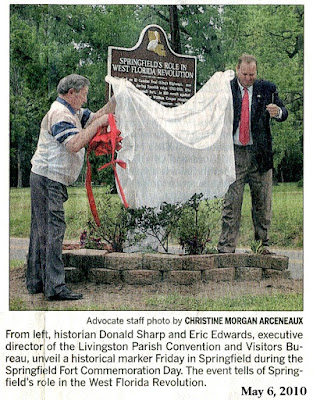A historical marker telling how Springfield, LA, played a part in the West Florida Revolution was unveiled in May of 2010, with a number of area history enthusiasts on hand to take part in the commemorative event.
The ceremony took note of the Bicentennial of the West Florida Rebellion, which took place two hundred years earlier in 1810. The Republic of West Florida was comprised of several Louisiana parishes, those east of the Mississippi River above New Orleans which had been part of Spanish West Florida (and British West Florida) for years.
Click on the images to make them larger.
Those parishes were East and West Feliciana, East Baton Rouge, St. Helena, Livingston, Tangipahoa, Washington and St. Tammany. The town of Springfield was central to the rebellion, which created the Republic of West Florida, with its "capital" in St. Francisville.
The republic also extended across the future Mississippi and Alabama state lines to the western boundary of the Florida panhandle.
Springfield is located on La. Hwy. 22, which traces in part, the old "El Camino Real," (or The King's Highway), a key Spanish route back in 1783 to 1810. A stockade or small fort was located in the community.
In a Morning Advocate article written by Christine Morgan, she said, "In 1810, during a revolt against Spain, residents led by William Cooper remained loyal to Spanish authority, but rebels, led by Gen. Philemon Thomas, prevailed at Baton Rouge with the help of 44 grenadiers from Springfield under command of Col. John B. Ballinger. There they helped capture the Spanish fort on Sept. 23, 1810."
Denise Martin, a Springfield organizer for the event, said Springfield had to play a part in the bicentennial celebration because of its close ties to those events from 200 years earlier.
Donald Sharp, area historian, and Eric Edwards, the executive director of the Livingston Parish Convention and Visitors Bureau, were given the honor of unveiling the historical marker detailing Springfield's participation in the historic event.


